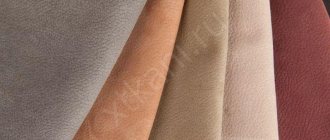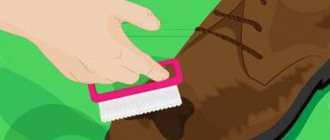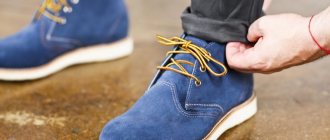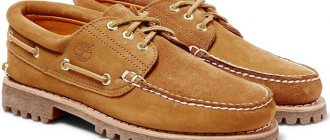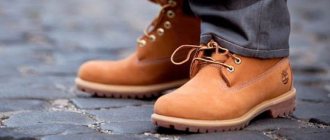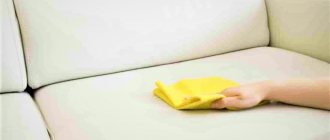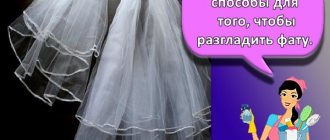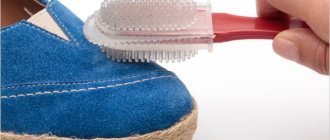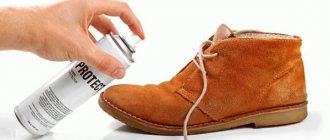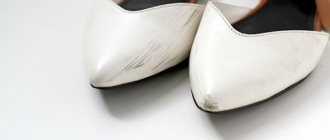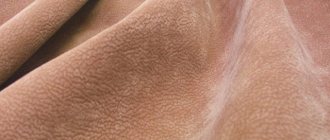If you came to read this article, it means you definitely have at least one pair of nubuck shoes or other products made from this material. In this article, you will get acquainted with basic care products that will make cleaning nubuck shoes at home much easier.
Looking ahead, let's say that the main emphasis was placed on the care of shoes made of this material, but they will also be relevant for other products and interior items made of nubuck.
Source: @ru_fashion_shop
Differences from suede
Nubuck and suede have a similar appearance, so it’s easy to confuse them. But they still have differences: quality, price, properties, service life. Here are the main features by which you can find out what kind of shoes you have in front of you:
- External differences. Both materials are velvety and delicate to the touch. However, nubuck has a shorter pile than suede. The latter type of leather is fleecy on both sides, while the former is fleecy on only one side.
- The raw materials for their production are also different. Suede is made mainly from the skin of small livestock: sheep and goats. The starting material for nubuck is the skins of large domestic and wild animals: oxen, yaks, elk, deer and others.
- Method of dressing. Suede is made through a tanning process with fats and formaldehyde, and for nubuck leather is treated with salts, chromium, and then polished with fine abrasives (sand, skins, etc.).
- In terms of physical properties, it turns out to be thicker, tougher, and abrasion-resistant compared to suede.
- Man-made materials also differ: nubuck is created by layering a synthetic substance, while suede is created using fabric and microfiber threads.
- Suede is not so durable, dense, it can be washed occasionally.
Features of the material
Thanks to the peculiarities of the material, nubuck is used to make beautiful and elegant shoes, in which the foot is not cold in winter and not hot in summer. Many people avoid purchasing nubuck boots or shoes because of the need to provide them with difficult care, but in fact, keeping such shoes in order is not as difficult as it seems at first glance.
Natural
Natural nubuck is made from cattle hides by chrome tanning, the front part of the material is polished with abrasives. Externally, nubuck is similar to suede, but its pile is smaller, and the raw materials are different. To make suede, as a rule, they take the skins of small cattle.
Artificial
Synthetic material does not differ in appearance from natural material, but differs somewhat in characteristics.
Artificial nubuck is cheaper, stronger and more durable, but the foot does not breathe in it, which is why wearing it is not as comfortable as natural one.
Nubuck-oil
To improve the water-repellent properties of natural nubuck, it is impregnated with fats of animal origin, which is how nubuck oil is obtained. To the touch and appearance, this material differs from ordinary velvety material; it is somewhat moist. Impregnation makes nubuck oil more wear-resistant, and shoes made from it are durable.
Rules of care
Shoes and boots with a shiny coating must be cleaned after each use, soften the material and protect it
But when caring for demanding material, special attention should be paid to the choice of tools and the rules for their use.
Material selection
The varnished surface is wiped only with a soft cloth made of flannel or microfiber, or with a cotton pad.
Efforts
Don't rub your shoes too hard. The pressure should be light, otherwise microdamages may occur on the surface, which will accumulate dust and eventually spoil the appearance of the product.
What not to use
When choosing products and tools for caring for patent leather shoes, you must avoid the following substances or equipment:
- Do not clean with hard brushes.
- Powdered abrasives will leave scratches.
- Compositions containing alcohol are harmful to the varnish film.
- The use of soap solution is unacceptable due to the alkali content in it.
Review of professional products
Along with patent leather shoes, you can immediately choose care products in the store. Shoe cosmetics vary in cost and functionality, which makes it possible to purchase specialized or universal options for every taste and budget.
Below are products from brands that have a positive reputation.
Saphir Vernis Rife
Using the French product Saphir Vernis Rife, you can clean both natural and artificial patent leather, giving it a deep mirror gloss. The liquid is evenly applied to the surface using the napkin that comes with the kit, and polished with a velvet cloth without waiting for it to dry.
Salamander Prof Lack Care
Salamander Professional Lack Care foam cleaner is designed for cleaning and caring for all types of patent leather. The product easily and conveniently removes dust and traces of grease, while keeping the skin soft, elastic and restoring the color of products. The foam is applied to a previously cleaned surface, which is then polished.
SALTON Professional
The SALTON Professional line includes both universal products suitable for the care of all types of shoes, and those specifically designed for trendy materials. The latter includes cream for patent leather shoes of natural and artificial origin. The product adds shine after polishing and protects against moisture.
Salamander Lack Polish
German colorless cream is designed to protect and clean natural and synthetic patent leather. The product is applied with a soft cloth to the surface, which is polished after drying. After treatment, patent leather shoes will have a mirror shine.
Twist Casual Care
Twist Casual Care cream gloss for smooth skin is available in small brightly colored tubes with a built-in applicator. The product carefully cares for the material, restores color, adds shine, and protects against precipitation and reagents. It compares favorably in price.
Collonil Classic Lack Mousse
Collonil Classic Lack Mousse spray foam maintains the shine and elasticity of patent leather, prevents cracks and provides protection. The mousse is applied to a previously cleaned surface with a soft cloth, and then polished.
Famaco Huile Vernis
Famaco Huile Vernis patent leather conditioner removes dust, stains and dirt from the surface, protects and maintains shine. The advantage of the product is that it prevents cracking, abrasion and burnout of the material. Regular use of conditioner will help maintain the glossy and supple appearance of patent leather shoes.
Silver
Turkish shoe cosmetics SILVER are suitable for daily care, deep cleaning and restoration of shine of shoes made of different materials, including patent leather. A wide range of products will allow you to choose products that will protect shoes from moisture and dirt, restore elasticity, moisturize and polish.
Tarrago
Shoe care products, tools and accessories from the Spanish brand Tarrago are sold all over the world. Patent Leather Cream is used to clean the material, soften it and add shine. The product will protect shoes from stains and cracks.
Daily care rules
To prevent nubuck from losing its appearance, it is necessary to care for your shoes or boots after each use. Shoes must be regularly dried, cleaned, and also prepared in advance for the next wear, treated with water-repellent agents.
General recommendations
When caring for nubuck shoes, you need to keep the following points in mind:
- Boots or boots should be cleaned daily.
- Only dry material should be cleaned; wet material may deteriorate.
- Nubuck boots should be dried away from radiators and other heating devices.
- When cleaning the surface with a brush, the treatment should be carried out in one direction - against the pile. Do not move the tool back and forth or make circular movements.
- It is better to carry out care using specialized tools and equipment.
Pre-cleaning
Cleaning and drying shoes is necessary before all other manipulations. After returning from the street, dry shoes are cleaned of dust with a brush. This must be done every time so that the dirt does not get stuck.
Cleaning dirt
If after standard brushing there are still traces of dirt on the shoes, the material is cleaned with a special eraser. You need to rub with a little force, but not so vigorously as to damage the delicate surface.
If the eraser does not help, or the area of contamination is quite extensive, resort to special cleaners in the form of foam, shampoo or balm.
Difficult to remove stains, abrasions and scratches are masked with a dye of a suitable shade.
In extreme cases
The appearance of dirty nubuck can be improved by treating the surface with a solution of water and a small amount of ammonia. Use a cotton swab soaked in the product to gently wipe the material.
You can get rid of heavy dirt and restore the presentability of nubuck boots by holding them over steam. After the procedure, the pile is combed with a brush with metal bristles.
Caring for nubuck shoes
In order for products made from this material to retain their appearance for a long time, you must adhere to the following rules:
- Avoid wearing in rainy weather. Do not allow the material to get too wet.
- Do not dry on heating devices. You can use special electric dryers or stuff the products with paper.
- To clean the surface, use a special brush, and dirt from the sole and heel can be wiped off with a damp cloth.
- Care must begin from the day of purchase. Impregnation for nubuck is immediately sold in stores. You should treat the surface before going outside for the first time and do this 3 times a week, drying the shoes before the next treatment.
- Apply any care products only to a dry, clean surface.
- You can make cleaning the product easier if you treat the material with a water-repellent agent every evening or a few hours before leaving the house and dry the shoes.
Care products
For care you should purchase:
- a special brush;
- stain removing eraser;
- shampoo for salt stains;
- coloring spray to match;
- hydrophobic aerosol against moisture and dirt (colorless or to match the shoes).
Cleaning
Special sprays, shampoos and foams at home allow you to properly care for nubuck products. This material strongly absorbs moisture, so it must be dried.
Dry brushing should be done every evening. It is necessary to treat the skin with a brush and remove dirt from other parts. An eraser is used if necessary.
If nubuck is significantly soiled, wet cleaning is required.
It is unacceptable to use a machine wash, but you should also be careful when washing it by hand. Minimum amount of water should be used
A special shampoo is used. Cleaning is carried out according to the instructions included with the product.
Dyeing nubuck
When the material loses its brightness, becomes dull, abrasions and difficult-to-remove stains appear, special coloring agents are used. They help restore the appearance of products. Recommendations for applying paint:
- Apply the product only to a cleaned and dry nubuck surface.
- When spraying, keep the can at a distance of 30 cm from the material to ensure uniform application.
- The procedure must be carried out in a ventilated area.
- After the paint has dried, a water-repellent agent is applied.
Shoe storage
If you do not plan to wear shoes for a long time, you must follow the rules for storing them:
- The nubuck surface must be cleaned and dried. Dirt is removed from the sole and heel.
- The shoes are impregnated with a caring spray, adding softness.
- The inner surface is treated with an antiseptic.
- It is best to store products in a box with a tight lid and good ventilation.
When the top layer of the product dries out, it should be treated with a special product.
Shoes made of nubuck require painstaking care, but with careful care they will delight you with their beauty for a long time.
Prevention after treatment
Infection with foot fungus usually occurs in places where it is customary to walk barefoot, for example, on the beach, in a swimming pool, in a public bath, in a gym with a shared shower. To avoid catching an infection in these places, treat your feet with antifungal agents before and after visiting.
It is best to use plastic shoes in the pool, as this is the least favorable environment for the growth of fungal spores. Choose sports shoes made from natural materials and suitable in size.
You can also become infected with the fungus at home, especially if you live near elderly or sick people. One of the main reasons for infection may be weak immunity. Therefore, a general strengthening of the body’s immunity will help prevent, among other things, fungal diseases. Try to breathe fresh air more often, eat healthy food and toughen up. If any signs of fungus appear, immediately consult a mycologist to prevent further development of the disease in the early stages.
Share link:
Caring for artificial and oiled nubuck
In addition to natural, there is artificial and oiled nubuck. Artificial has high wear resistance because it is made from leather substitute. At the same time, it is difficult to distinguish the material from its natural analogue; its only disadvantage is insufficient breathability.
It is not difficult to care for shoes made of artificial nubuck; it is less afraid of water, almost does not deform and does not absorb dirt as much. It is cleaned in the same way as natural; it can be treated with impregnation less often.
Oiled nubuck is often used in products. This natural material undergoes additional processing with special oils. It is smoother to the touch than traditional ones, but at the same time has high water-repellent properties. In boots made of nubuck oil, your feet will not sweat or get wet in wet weather.
High top sneakers. Material: oiled nubuck
If necessary, oiled nubuck can be wiped with a damp cloth, and instead of impregnation, special oils are applied to the shoes.
The following video will tell you in more detail about how to clean such shoes:
Masking scratches on artificial leather and leatherette
Faux leather shoes occupy the largest segment of the market due to their affordability. Manufacturers make a lot of effort to ensure that the material resembles genuine leather as much as possible. Thanks to the low price and realistic imitation of expensive material, users are increasingly giving preference to just such shoes, choosing them as everyday ones. Operating conditions are rarely gentle, and therefore the question of how to repair scratches on leatherette is one of the most pressing.
Experts recommend using the same products that are recommended for natural leather, as well as decoupage glue or the well-known PVA. Decoupage glue is more preferable because it contains substances that have adhesive and sealing properties. In addition, after its application, a film similar to varnish is formed.
How to cover up scratches that are quite deep and affect not only the surface, but also the inner layer of artificial leather? To do this, you must first apply the paint, and after it has absorbed and dried, treat it with an adhesive. This method is good for masking deep damage.
Nubuck shoes: daily and regular care
Simple care for shoes made of natural nubuck includes mandatory cleaning and processing procedures for the material to remove dust and dirt.
Before putting your favorite pair on the street for the first time, it is necessary to prepare it and treat it with special means; shoe owners are recommended to use several types of care:
- primary treatment of the outer surface with the application of a special impregnation that repels moisture and prevents the settling of dust and the appearance of contaminants;
- daily care is required when wearing shoes every day and after each exit to the street, thoroughly dried nubuck should be cleaned of dirt and dust;
- Regular seasonal procedures include preparing shoes for upcoming storage, for which they are thoroughly cleaned and placed in a box.
Moisture-repellent impregnation should be applied before the first time wearing shoes outside in several layers, evenly distributing the composition over the entire surface of the material.
Caring for white shoes at home
White leather shoes require special attention because they undergo additional processing during the bleaching process, which makes them flexible and soft, but also more susceptible to dirt. When buying a pair of white shoes or boots, it is best to immediately purchase cream, paint and other care products and tools in the store.
However, sometimes for cleaning you have to turn to improvised folk remedies.
Toothpaste
To clean white leather shoes with toothpaste, apply it to the surface using a special shoe brush, rubbing in with light movements. The dried paste is removed with a damp cloth.
Baking soda
Baking soda works well to remove dirt from fair skin, but it is not recommended to use the product more than once a month, as yellow spots may appear. To clean white boots, prepare a solution from a glass of water and one tablespoon of soda, apply it to the surface and wait until it dries, after which the residue is removed with a soft brush.
A mixture of milk and raw egg
To clean light leather shoes, beat the white of one egg and half a glass of milk. The mixture is applied to the skin and left to dry. Dried residues are brushed off.
Table vinegar
It is not recommended to use vinegar in its pure form, since the product is quite strong. To clean, mix 1 part vinegar with 10 parts water, wipe the contaminated areas with the solution, then rinse with water and wipe dry.
Onion juice
To prepare the juice, grate the onion on a medium grater and squeeze. The resulting composition will perfectly cope with any stubborn stains and polish the surface. A cotton pad is moistened with onion juice and lubricated with shoes, especially carefully treating scuffed and contaminated areas, after which they are wiped dry with a napkin. Shoes cleaned with onions are left to air for several days so that the onion smell goes away.
Talc and turpentine paste
By adding turpentine to talc or baby powder, you get a paste that can be used to clean white shoes. The composition is applied to the stains and pressed with glass to penetrate deeply into the material, where the mixture absorbs grease and dirt. After cleaning, the product is carefully removed with a brush.
Removing Special Stains
If the origin of the contamination is known, then it is easier to choose a product that will cope with it. It is best to use professional shoe cosmetics for deep cleansing and removing stains, but in its absence, you can resort to traditional methods of combating different types of stains.
Greasy spots
If greasy stains appear on the surface of nubuck shoes, use regular semolina. The cereal is rubbed into the problem area, replacing it with fresh one as needed.
Salt
In winter, white stains form on shoes or boots due to the anti-ice reagents used. It is most difficult to remove such stains from fleecy shoes. To remove stubborn salt stains, it is best to use professional cleaners, but there are also several time-tested folk remedies:
- The most famous method is to remove white spots using a vinegar solution, which is prepared by adding a tablespoon of the product to a glass of water.
- A mixture of a teaspoon of baking soda and half a glass of milk, to which you can add a few drops of ammonia for effectiveness, will help get rid of salt stains. The product is applied with a soft cloth, then removed with a cotton pad soaked in clean water.
- White stains are removed with tooth powder, which is spread in a thin layer and removed along with the absorbed salt.
- Shoes contaminated with reagents are cleaned with steam. To do this, you can use a steam generator or hold it over boiling water. The salt released during the processing process is removed with a polyurethane brush.
Fat
A piece of food, sauce or other oily liquid may fall on your shoes. Stains left by oil or other greasy substances are removed as follows.
Starch
Grease stains are removed using absorbents such as potato starch, baby powder, talc, baking soda and salt. Oily dirt is covered with an even layer of powder for several hours, after which it is brushed off. If necessary, the procedure is repeated several times.
See also
How to clean a toilet brush at home, rules and best remedies
Vinegar
A weakly concentrated solution is prepared from vinegar and water, which is used to treat the oil stain using a soft cloth or cotton pad. You can spray the mixture with a spray bottle.
From an unpleasant odor
To get rid of unpleasant odor, the inner surface of the boots is treated with an antibacterial agent. Hydrogen peroxide copes well with this task. The product is sprayed and left to act for a while, then the shoes are wiped with a damp cloth and dried.
Rules for caring for nubuck shoes
To preserve the original color of the material for a long time, do not wear boots, shoes, sneakers or boots made of nubuck in rain and wet weather, or at temperatures above 35 degrees. Due to heat and high humidity, the material cracks and deteriorates, losing its shape.
You cannot wash or clean nubuck shoes under running water or in a basin of water, as a large volume of water has a negative effect on such skin.
Be sure to use nubuck shoe care products, including:
- Cleaning milk, shampoo or balm for suede and nubuck. Instead of such a product, you can prepare a regular soap solution. To do this, dissolve a teaspoon of liquid soap in a liter of water. Or grate a piece of solid soap on a coarse grater and also add to the water. Stir the mixture until foam forms;
- Soft rags and sponges, cotton pads, brushes with sparse soft brass bristles for suede or nubuck shoes. Under no circumstances should you use hard brushes or sponges!;
- Among caring creams and other products, choose dirt- and water-repellent sprays, liquid or gel impregnations. Such products must be designed specifically for this type of material! You can use polish for nubuck and suede shoes. You cannot take universal creams, products for regular or patent leather!;
- Coloring aerosols and sprays will help restore the color of the material, paint over scuffs, stubborn stains and stripes.
In addition to purchased products, it is important to know how to clean nubuck shoes at home effectively, quickly and without harm to the material. After each wear, natural and synthetic nubuck should be brushed to remove dust, dried dirt and sand.
To clean nubuck shoes from dirt, soak a cotton pad in a soap solution or a special product for washing nubuck and suede shoes. Gently wipe the surface with the disc and then rinse off the product with a soft sponge or cloth soaked in clean running water. Then the material is wiped with a dry cloth and left to dry.
How to stretch
If nubuck shoes are tight, it is easy to stretch them due to the softness of the material. Some shoe stores offer free stretching services, which will be performed by a professional using special compounds and pads. You can also adjust the size yourself at home.
Special product
Store-bought stretchers, which are usually available in cans, are sprayed inside the shoe onto problem areas. After this, the pair is put on and worn in for several hours, during which time the shoes take on the shape of the foot. If necessary, the procedure is repeated until a positive result is achieved.
Package without holes
Stretching in this way takes advantage of the property of water to expand when it freezes. A thick plastic bag is placed in the shoe, filled with water and tied, it is important that there are no holes and water does not spill directly into the shoe. The structure is placed in the freezer, where the liquid turns into ice, increases in volume and stretches the shoe.
Hot water and wool socks
Tight boots can be broken in if you put them on a wool sock and walk around for a while. In order for the material to stretch better and faster along the foot, a little hot water is first poured into the shoes. The shoes prepared in this way are worn until they cool down.
Caring for suede shoes
Caring for suede shoes should begin with treating them with a protective spray, which forms a transparent layer on the surface of the product that prevents the penetration of moisture and dirt. This procedure will protect your new thing. Thanks to spray treatment, suede will not get dirty so quickly and will be able to retain its original appearance longer.
To achieve the desired effect, primary care for suede shoes should be carried out 3 times:
- First we moisten the surface with an aerosol;
- let the shoes dry away from heating devices;
- repeat the procedure several times.
After the first walk, for preventive purposes, you should refresh the suede surface. To clean suede you will need a hard porous sponge brush; it, in combination with a foam cleaner, will quickly remove the top layer of dust. In addition, you need an eraser that will remove stubborn stains and greasy deposits, or a brush with rubber teeth that performs the same functions. For convenience, you can purchase a miniature brush with a 2 in 1 eraser.
It should be remembered that suede shoes should only be cleaned when dry. In addition to the water-repellent spray, you will need aerosol paint to restore color; at the same time, it also serves as an impregnation for the surface of the shoe. The most universal option would be a transparent spray that reliably maintains skin color, but to add brightness, it’s worth looking for the appropriate tone.
To spend a minimum of time searching for shoe cosmetics, you can pick up a set of suede care products directly in a shoe boutique. Since many brands have long been producing their own lines of cosmetics for shoe care.
Despite the fact that suede is a breathable material, it is necessary to regularly refresh it with a special deodorant. And at the end of the season, you should “preserve” cleaned and tinted suede shoes using a shoe last to preserve their shape, so they will look like new for a long time.
How to clean nubuck shoes at home from heavy dirt?
If your shoes are very worn, we recommend contacting a dry cleaner for professional help to restore them to their original appearance. You can try cleaning nubuck shoes at home. To do this, use one of the following tools.
Ammonia
Using ammonia, you can clean white salt stains that often appear on shoes in the winter.
Mode of application:
- Prepare a solution of water and ammonia in a ratio of 4:1
- Thoroughly dry the nubuck product with a sponge soaked in the prepared solution.
- Dry the shoes well, then hold them over steam to straighten the pile.
- Rub the nubuck with a brush and apply paint.
Vinegar
Table liquid is also an excellent assistant in cleaning shoes made of delicate natural material.
Mode of application:
Mode of application:
- Apply a small pinch of salt to the stained area and rub gently with a sponge.
- Wipe the surface with a damp cloth.
- Dry the shoes and thoroughly brush the surface with a wire brush for nubuck.
To clean light nubuck shoes, you can use all the methods described above. But please note that the process will take a little more of your time.
Cleanup tactics
If your shoes are exposed to precipitation and become dirty, you need to know how to properly clean them. We are waiting for the boots to dry at home. You can speed up the process using electric dryers, available for sale at any shoe store.
Next, use a nubuck eraser. Apply it pointwise to the area of contamination. Reviews claim that an ordinary stationery eraser copes with this task with a bang. Afterwards, go through with a brush, combing the pile. If stains or dirt cannot be removed, then seek help from shoe shampoo and conditioner. As a rule, such therapy gives positive results and the shoes become clean again.
However, if this does not happen, you will have to resort to paint to restore the color of the product. The color is selected as close as possible to the original. In the future, a new bottle is purchased of a brand and tone identical to the first one. The final stage is an aerosol coating that prevents moisture. The spray can is sprayed only after the boots have dried out from previous exposures.
Drying shoes correctly
Any care, cleaning after a walk, removing stains, restoring color and other procedures should only begin when the shoes are completely dry.
That is why special attention is paid to the drying process
Nubuck should dry naturally, without the use of any heating devices. Even electric drying insoles are prohibited. Exposure to high temperatures leads to skin deformation and drying out.
Shoes that get wet from rain or snow will need at least 4 hours to dry completely. You can speed up the process if you stuff paper inside and periodically, as it gets wet, replace it with a new one.
Nubuck care - primary and daily
Cleaning nubuck at home is not difficult, the main thing is to do it carefully so as not to spray paint on the wallpaper or furniture. If possible, it is better to go out onto the balcony or into a well-ventilated room. Complaints that nubuck gets wet indicate that the owner of such things does not take care of them and did not soak the shoes before going out for the first time.
Take the purchased impregnation and carefully read the instructions for use. Treat your shoes with it three times. Between each application, take a break until the previous layer is completely absorbed. The same thorough treatment should be repeated during rains and snowfalls.
This is how the nubuck was originally cleaned, how should it be taken care of on a regular basis now? Use a damp cloth to remove dirt from the sole and heel. A brush is used to clean shoes from dust and debris and apply impregnation, but now only once. Do not forget a very important point: such shoes should only be cleaned dry.
If you drive a car, always use a pad (auto heel) to prevent dirt or abrasion of the lint. Ideally, it would be if these actions are daily, if boots or shoes made of nubuck or suede are worn every day.
How to paint nubuck
If scratches have formed on the shoes or, for various reasons, the color of the leather has changed in certain areas, many owners of nubuck items decide to dye it. For successful painting you should:
- Dry the nubuck product thoroughly,
- Clean it from dust and dirt using special or improvised means,
- To remove the water-repellent film, wipe the nubuck with the rubber part of the eraser,
- The product is dried again
- The skin is covered with paint,
- Nubuck is dried and coated with impregnation.
If you purchased an aerosol paint, the can should be kept at a distance of 15–20 cm during application so that the color turns out natural and goes on evenly. Painting is carried out in a well-ventilated area or outdoors. In order not to paint the sole and stitching threads along with the leather, many people prefer to use cream paint. During the procedure, it is applied to a sponge, with which the nubuck product is carefully impregnated. Depending on the condition of the leather, you can paint it in several layers, but each subsequent one is applied after the previous one has dried.
The author’s experience suggests that if you don’t want to ruin half the furniture in the room with paint and show off colored spots on your hands, the painting procedure should be done on the balcony or street, if your home allows it. Moreover, gloves should be put on your hands, and normal clothes, even home clothes, should be replaced with rags intended for disposal. For ease of work, the shoes themselves can be placed on a stool covered with newspaper or oilcloth.
Proper care of nubuck shoes
Correctly selected means of protecting the product is 70% of success in maintaining the good condition of shoes, but the entire line for natural pile leather is very expensive.
A complete list of cosmetics for proper care of nubuck is included in the following memo:
- Water-repellent impregnation in the form of a spray or separately applied liquid. It is economical to purchase a colorless version;
- Brush for nubuck and suede - single- or double-sided. It can be made of metal or with dense short pile;
- Shampoo, foam to remove dirt;
- Paint matching the color of the shoes;
- Dry cleaning eraser;
- Spray conditioner for the inside of shoes.
You should use shampoo for general cleaning of shoes no more than three times a year, when you need to restore the external gloss not in a separate area, but over the entire surface of the shoes or before putting them away for storage. The brush is used as a tool for fluffing up rough hair, for dry cleaning and giving a velvety texture after wet cleaning.
The dye is purchased in advance, and not when the shoes are worn out, since properly caring for a nubuck pair also means promptly tinting shiny areas or masking traces of salt reagents. The paint is selected in the form of an aerosol, the color of which, when the liquid dries, matches the color scheme of the product itself. This is necessary to carry out spot restoration, if necessary, and not to paint the entire boots.
Impregnation is needed to systematically protect shoes from moisture and liquid dirt. An eraser can be used to clean stubborn stains, but after using it, you must immediately restore the fluffiness of the pile with the metal side of the brush.
Dry nubuck products, just like suede, at room temperature, away from sources of artificial air heating. Before drying, wet shoes are stuffed with newspaper to prevent deformation and wrinkles. Nubuck pairs are stored clean and dry in boxes, at average temperatures and away from humidity. Storage in plastic bags is unacceptable - this way the material “suffocates” during inactivity and acquires a strong specific odor.
Ready-made products
Shoe stores offer a huge number of specialized care products for such products, which help keep them in their original form:
- Water-repellent substances. They form a thin waterproof film that protects products from dampness and helps to quickly clean external contaminants. You should oil your shoes with this product immediately after purchase.
- Brush. Hard brushes cannot be used for cleaning, so you need to purchase a special one suitable for such materials.
- Eraser. Helps quickly remove dirt and stains, leaving the surface clean and shiny.
- Cream, paint for nubuck products. Using such products you can quickly refresh the appearance of your shoes.
- Shampoo. Shoe shampoo copes not only with ordinary dirt, but also helps remove salt stains.
- Deodorant. The unpleasant odor after prolonged wear quickly disappears after treatment with this product. It also helps fight bacteria that accumulate on the inside of shoes.
Creams and impregnations for nubuck contain lanolin, which creates additional protection against moisture
Among the modern companies producing nubuck care products, the following have proven themselves: Ecco, Salamander, Timberland. The only disadvantage of store-bought care products is the high cost. If you can’t buy them, you should use homemade recipes, which are often no less effective.
In order for shoes to last longer, you should use special impregnations that protect the material from mold, salt, moisture, etc.
ROOM
RESULTS °Ð¶Ð¸Ð²Ð°ÑÑ Ð·Ð° кожей нÑбÑк? RESULTS RESULTS ±ÐºÐµ изделиÑ. RESULTS ›
RESULTS AND CONDITIONS живаÑÑ Ð·Ð° ж ROOM reciprocal:
- RESULTS ¾ÑÑи â ÑÑаÑелÑно пÑойдиÑеÑÑ Ð¿Ð¾ Ñвам и ÑÑÑднод RUSSIAN ¿Ð½Ñм меÑÑам;
- RESULTS ¾
Ð Ñом, как вÑвеÑÑи клей Ð¼Ð¾Ð¼ÐµÐ½Ñ Ñ Ð¾Ð´ÐµÐ¶Ð´Ñ Ð²Ñ Ð´ÑÑгой инÑÑÑÑкÑии.
RESULTS и Ñамой аккÑÑаÑной ноÑке небоР»ÑÑие повÑÐµÐ¶Ð´ÐµÐ½Ð¸Ñ Ð²Ð¾Ð·Ð½Ð¸ÐºÐ°ÑÑ. ROOM ¸ из иÑкÑÑÑÑвенного нÑбÑка (или на SYSTEM:
- RESULTS;
- RESULTS;
- RESULTS еÑки;
- RESULTS ¿Ð¾Ð»ÑзÑйÑеÑÑ ÑампÑнем-пенкой;
- RESULTS ÑÑÑ Ð²Ð»Ð°Ð³Ð¾Ð·Ð°ÑиÑнÑм аÑÑозолем.
Ð ÑепеÑÑ Ð½ÐµÐ¼Ð½Ð¾Ð³Ð¾ ÑезоннÑÑ Ð¾ÑобенноÑÑей! RESULTS:
- RESULTS Ñпкой;
- RESULTS;
- RESULTS ¼ ÑÑедÑÑвом.
RESPONSIBILITY, RESPONSE ¾Ð¼ зимой:
- RESULTS ми ASSURANCE CONTACT US;
- RESPONSIBILITY ¸Ðµ SMALL ¿Ñнем, не оÑÑавлÑйÑе на поÑом;
- RESULTS › Ñе он ÑаÑÐ°ÐµÑ Ð¸ повÑÐµÐ´Ð¸Ñ Ð¿Ð¾Ð²ÐµÑÑноÑÑÑÑ.
RESULTS, ASSURANCE › › › › › ¸Ð»Ð° ÑÑода за обÑвÑÑ!
https://youtube.com/watch?v=ycp7_UDtTY8
Nuances of caring for nubuck
In general, all care for shoes made of such delicate material should be systematic. Cleaning should be done every day, morning and evening. Wet and damp boots are pre-dried in a warm and ventilated area. Under no circumstances should a heater or battery be used for these purposes. At the end of cleaning, do not forget to apply a tinting aerosol and water-repellent impregnation.
You cannot use standard shoe creams and sprays, but only specialized ones. It is better to remove white stains immediately with a damp cloth. Remember to comb the pile with a special brush. If possible, it is recommended to use only special products from well-known brands for cleansing.
Do not wipe nubuck with wet rags, as this will ruin the surface quality of the material. If wet cleaning is required, use water with ammonia and a damp flannel cloth soaked in this solution.
To get rid of the problem of odor inside shoes, it is better to have two pairs of them for the season to dry every other day. If this is not possible, then hydrogen peroxide will come to the rescue. It is poured into a spray bottle and sprayed inside the shoes. Thus, all bacteria, which are the culprits of the unpleasant odor, will very quickly die. After some time, wipe the shoes from the inside and dry them for a couple of hours.
In the absence of hydrogen peroxide, furatsilin can cope well with this problem. They take several tablets - about four. Dilute them with a small amount of water. Furacilin will cope perfectly with bacteria that are responsible for the unpleasant odor. The inner surface is wiped with a cotton swab dipped in this solution.
It is worth noting that the means of removing unpleasant odors can be anything - activated carbon, soda, vodka - anything that can kill bacteria.
If your shoes are heavily soiled and cannot be cleaned by hand, it is best to go to a dry cleaner.
As for storage, boots should be kept in well-ventilated boxes. Before placing them there, a protective impregnation should be applied.
The question of whether nubuck can be washed in a washing machine disappears by itself. It's better not to do this. Standard hand cleaning gives much better results and keeps the surface of the material in excellent condition.
We restore light-colored shoes and white sneakers
Fashionistas will confirm that the most popular colors in the spring-summer period are pastel shades, beige, gray and white. The light surface is very susceptible to dirt, and elegant sneakers or delicate pumps quickly lose their appearance. Fresh asphalt, the use of mats, seals and other rubberized surfaces in transport cause black scratches to appear on white shoes, which can be difficult to get rid of.
There are several options for getting rid of these types of marks. For patent leather shoes, you can try using gasoline if a simple school eraser does not help. Marks on light-colored shoes made of genuine leather are removed with a swab dipped in milk. A special liquid cleaner or a melamine sponge is suitable for cleaning sneakers. You can also wash a pair of sneakers in the washing machine without even removing the laces. For a cloth pair, you can use the old fashioned method - tooth powder with a drop of lemon juice. After the mixture is evenly distributed, the shoes can be exposed to the sun to better whiten the dark marks.
Advantages
Modern material is gaining more and more popularity among shoe manufacturers, and the market demand for such products is growing.
The following main advantages of the material can be identified:
- Pleasant to the touch;
- Performs well the function of thermal insulation;
- Does not stretch during wear, like, for example, genuine leather;
- Does not become hard in the cold;
- It lasts a long time and is not prone to cracking.
If you do not ignore the rules for cleaning capricious shoes, you can significantly extend their service life and save a lot of money.
Another type of material based on nubuck is Nubuck-oil, a variety in the production of which oil was used. With oiled material, moisture permeability decreases, and the wear resistance of shoes increases significantly. The only drawback is that the products weigh a little more.
What is nubuck oil?
Natural nubuck treated at the production stage with fat impregnation is called nubuck-oil. Although outwardly it looks a little rougher and is actually heavier than its regular counterpart, its advantage is its impressive water-repellent properties - this property of nubuck oil is used in the production of sports shoes.
Externally, nubuck-oil is quite distinguishable from ordinary nubuck: fat impregnation makes it dark and smooth. Nubuck oil is ideal for people leading an active lifestyle - caring for such sneakers and boots is easier because they are not afraid of water. But cleaning ordinary nubuck must be carried out according to certain rules.
How to clean at home
To “bring back to life” your favorite summer shoes, soft boots, it is not at all necessary to turn to experts in reading nubuck shoes. What you will need:
- dirty shoes, ballet shoes - one pair;
- cleaning products (eraser, spray, foam);
- alternative (salt, starch, ammonia).
Before cleaning, shoes must be prepared - dried, large fragments of dirt are removed from them.
Wash the soles from dirt
Of course, you will need to carefully wash your shoes before cleaning them. This must be done so that the liquid does not get on the nubuck.
It is best to wipe the sole and heel with wet wipes or a wrung out cloth, but do not wash it under running water. You will need to remove as much dirt as possible and then dry the shoes.
Drying
Nubuck products are dried not haphazardly, but in a special way. It is better to get a special electric dryer that works from inside the shoes. If there is no such device, it doesn’t matter. Old newspaper, divided into sheets and crumpled, has long been known as a proven folk remedy for drying shoes. It is enough to place a few paper lumps in the shoes, and then, as they get wet, replace them with fresh ones.
Shampoo solution for surface treatment
It is permissible to use a special shampoo for cleaning. Experts do not recommend using this method too often. Contact with liquid is harmful for nubuck in any form.
We use paint and tape to protect decorative elements
The use of special impregnations with a coloring effect (aerosol paints) on nubuck requires preliminary preparation. The inserts are made of a material of a different color; the heels are sealed with paper (painting) tape so that they do not change color. And then the paint is carefully applied to the shoes. Once the process is completed, the tape is removed.
How to raise the pile
To raise the pile on nubuck, you can use a method that is used for the same purpose for suede. To do this you should:
- Pour 2/3 of water into a large container - a saucepan or kettle,
- Bring the liquid to a boil and open the lid.
- Hold your shoes or bag over the steam for 5–7 minutes,
- Nubuck is dried and cleaned with a special brush,
- Shoes or bags are coated with impregnation.
As an option, the author of the article rubbed the caked lint with an old toothbrush, however, this only helps in case of slight smoothness. I also tried to test the strength of my shoes by cleaning them with fine sandpaper; fortunately, this was done in an inconspicuous place. Although this method fluffs up the pile, it partially thins it out. A friend suggested such an extreme method as scraping nubuck with a regular knife, but the author did not dare try this method so as not to leave her boots “bald.”
Basic methods of disinfection at home
There are a large number of products on the market with which you can disinfect your shoes yourself at home. Let's look at some of the existing tools and figure out what advantages and disadvantages each of the tools has.
Mycostop spray
Mycostop is one of the most popular means for the prevention of fungal infections. It has a powerful bactericidal effect, which reliably protects feet and nails from harmful microorganisms. The product is safe for humans and at the same time reliably eliminates microbes that carry infections.
It can be used to treat feet after interacting with an unsafe environment, for example, after a bath or sports training, or used to disinfect everyday shoes.
Dezavid
This product does not contain elements such as alcohol, chlorine, acids and alkalis, so it does not spoil the material being processed at all. This is an economical product characterized by a persistent disinfectant effect that lasts for a long time.
It can be used both to eliminate harmful microorganisms and to prevent their occurrence. Helps prevent fungal infections from settling in shoes and eliminate unpleasant odors.
Bitsin
Bitsin spray is one of the most popular and effective shoe disinfectant sprays. Its advantages are its effectiveness coupled with an affordable price. The protective effect lasts up to forty days after use.
In addition to fighting microbes that carry fungal infections and eliminating unpleasant odors, the product also reduces foot sweating. Bitsin has a two-component composition. The active substances are mixed before use, resulting in a more durable, long-lasting protective effect compared to deodorants and antiperspirants.
Formidron
An antiseptic drug, also used for disinfection purposes. Its main active ingredients are ethanol and formaldehyde. Destroys the unpleasant odor of sweat and destroys harmful bacteria. Characterized by an affordable price.
